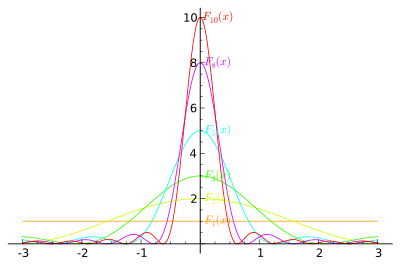Fejér kernel
From Wikipedia, the free encyclopedia
In mathematics, the Fejér kernel is used to express the effect of Cesàro summation on Fourier series. It is a non-negative kernel, giving rise to an approximate identity.

Plot of several Fejér kernels
The Fejér kernel is defined as
where
is the kth order Dirichlet kernel. It can also be written in a closed form as
 ,
,
where this expression is defined.[1] It is named after the Hungarian mathematician Lipót Fejér (1880–1959).
The important property of the Fejér kernel is  with average value of
with average value of  . The convolution Fn is positive: for
. The convolution Fn is positive: for  of period
of period  it satisfies
it satisfies
and, by Young's inequality,
![\|F_{n}*f\|_{{L^{p}([-\pi ,\pi ])}}\leq \|f\|_{{L^{p}([-\pi ,\pi ])}}](/2014-wikipedia_en_all_02_2014/I/media/2/6/8/c/268cc26b0bd7fee89c72a8c8e4d7dbb6.png) for every
for every 
for continuous function  ; moreover,
; moreover,
 for every
for every ![f\in L^{p}([-\pi ,\pi ])](/2014-wikipedia_en_all_02_2014/I/media/e/2/f/8/e2f84375054152203af9214f7730693c.png) (
( )
)
for continuous function  . Indeed, if
. Indeed, if  is continuous, then the convergence is uniform.
is continuous, then the convergence is uniform.
See also
References
This article is issued from Wikipedia. The text is available under the Creative Commons Attribution/Share Alike; additional terms may apply for the media files.


